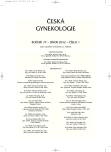Risk factors for recurrent disease in borderline ovarian tumors
Authors:
P. Líbalová 1; Z. Vernerová 2; L. Hubičková-Heringová 3; D. Pintérová 4; K. Tikovský 1; M. Kubecová 5; B. Svoboda 1
Authors‘ workplace:
Gynekologicko-porodnická klinika 3. LF UK a FNKV, přednosta doc. MUDr. E. Kučera, CSc.
1; Ústav patologie 3. LF UK a FNKV, přednosta prof. MUDr. V. Mandys, CSc.
2; Ústav histologie a embryologie 3. LF UK a FNKV, přednosta prof. MUDr. J. Stingl, CSc.
3; Gynekologicko-porodnická klinika, oddělení nádorové biologie 3. LF UK a FNKV, přednosta doc. MUDr. E. Kučera, CSc.
4; Radioterapeutická a onkologická klinika 3. LF UK a FNKV, přednosta doc. MUDr. M. Kubecová, Ph. D.
5
Published in:
Ceska Gynekol 2012; 77(1): 31-35
Category:
Original Article
Overview
Objective:
To evaluate risk factors for development of recurrent disease in borderline ovarian tumors.
Design:
Retrospective study of 10-years single institution population.
Setting:
Dept. of Gynecology and Obstetrics, 3rd Medical Faculty of Charles University in Prague.
Method:
59 consecutive cases of borderline ovarian tumors (BOT) were analyzed for age, histopathological type, DNA ploidy, stage, presence of invasive and non-invasive peritoneal implants, type of surgical procedure, residual disease, adjuvant therapy, recurrence and long-time prognosis of the patients.
Results:
Median follow-up was 47 months (range 1-144). There were 5 (8.5%) patients with DNA aneuploid tumors in the study group; 4 of them were younger than 50 years, 4 of them were early stage serous BOT; no one recur so far. No death of disease was described in the whole study group; only 2 patients (3.4%) developed recurrent disease – both were young patients after conservative surgery for serous diploid stage I/II BOT. Conservative surgery was the only significant factor for recurrence in univariate analysis (p = 0.0159) in our setting.
Conclusion:
DNA ploidy was not proved to be prognostic factor in borderline ovarian tumors in our study group. The only significant risk factor for development of recurrent disease was conservative surgery, with no influence on overall survival.
Key words:
borderline ovarian tumor, recurrence, risk factors, DNA ploidy, conservative surgery.
Sources
1. Heintz, AP., Odicino, F., Maisonneuve, P., et al. Carcinoma of the ovary. FIGO 26th Annual Report on the Results of Treatment in Gynecological Cancer. Int J Gynaecol Obstet, 2006, 95 (Suppl 1), p. 161–192.
2. Kaern, J., Tropé, CG., Kristensen, GB., et al. DNA ploidy; the most important prognostic factor in patients with borderline tumors of the ovary. Int J Gynecol Cancer, 1993, 3, p. 349–358.
3. Ren, J., Peng, Z., Yang, K. A clinicopathologic multivariate analysis affecting recurrence of borderline ovarian tumors. Gynecol Oncol, 2008, 110, p. 162–167.
4. Shih, KK., Zhou, Q., Huh, J., et al. Risk factors for recurrence of ovarian borderline tumors. Gynecol Oncol, 2011, 120, p. 480–484.
5. Trimble, CL., Kosary, C., Trimble, EL. Long-term survival and patterns of care in women with ovarian tumors of low malignant potential. Gynecol Oncol, 2002, 86, p. 34–47.
6. Tropé, C., Davidson, B., Paulsen T., et al. Diagnosis and treatment of borderline ovarian neoplasms “the state of the art”. 2009, 30, p. 471–482.
7. Winter, WE. 3rd, Kucera, PR., Rodgers, W., et al. Surgical staging in patients with ovarian tumors of low malignant potential. Obstet Gynecol, 2002,100, p.671–676.
8. Wu, TI., Lee, CL., Wu, MY., et al. Prognostic factors predicting recurrence in borderline ovarian tumors. Gynecol Oncol, 2009, 114, p. 237–241.
9. Yokoyama, Y., Moriya, T., Takano, T., et al. Clinical outcome and risk factors for recurrence in borderline ovarian tumours. Br J Cancer, 2006, 94, p. 1586–1591.
10. Zanetta, G., Rota, S., Chiari, S., et al. Behavior of borderline tumors with particular interest to persistence, recurrence, and progression to invasive carcinoma: a prospective study. J Clin Oncol, 2001, 19, p. 2658–2656.
Labels
Paediatric gynaecology Gynaecology and obstetrics Reproduction medicineArticle was published in
Czech Gynaecology

2012 Issue 1
Most read in this issue
- Is the hysteroscopy the right choice for therapy of placental remnants?
- To conclude knowledge about new colposcopic signs – ridge sign and inner border.
- Risk factors for recurrent disease in borderline ovarian tumors
- The psychosocial needs of newborn children in the context of perinatal care
